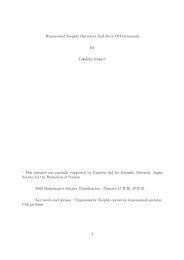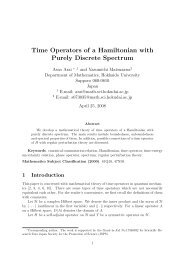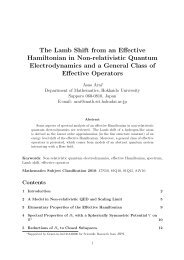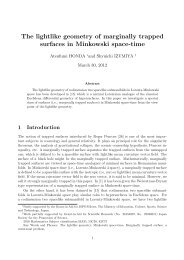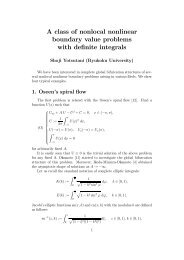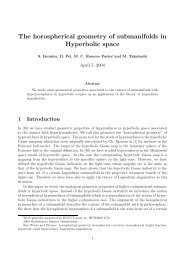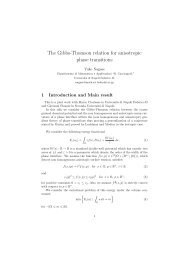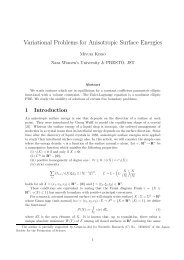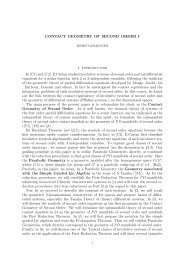- Page 1 and 2: Proceedings of the Meeting and the
- Page 3 and 4: Tadashi Ashihga(Z E ) (1)A Resoluti
- Page 5 and 6: of P, and let p, be the geometric g
- Page 7 and 8: (2) s s s, + - - - a ST In- 1 571 1
- Page 9: nonsingular rational curves N' and
- Page 13 and 14: 3 An inequality for a singularity E
- Page 15 and 16: [lo] H. Laufer: On normal twedimens
- Page 17 and 18: some sence. So it seems that the si
- Page 19 and 20: RPn-,O(ICx + S) = 0 for p - > 1, we
- Page 21 and 22: 1.6 Let S be a surlace defined by (
- Page 23 and 24: and gi by r respectively. Put r = 7
- Page 25 and 26: 0 d OE~L: (Dl + C hi) 4 OC(yl+)Lc)
- Page 27 and 28: By the above argument, the number O
- Page 29 and 30: Corollary 2.5 pg(~)=pg(S)-k, q(S)=g
- Page 31 and 32: y3 t Mk, let C'$ be the curve on W
- Page 33 and 34: where St = pP1(t) (t # 0) is a srno
- Page 35 and 36: Fig. 1
- Page 37 and 38: Appendix to T. Ashikaga's paper KAZ
- Page 39 and 40: ProoJ. TI I) holds, the11 Bs l4T -
- Page 41 and 42: of Lemma 2, we can cover the region
- Page 43 and 44: quadric hppersurface Q . Precisely
- Page 45 and 46: 5.1 General properties of a smooth
- Page 47 and 48: Prcof. he ha\-e the equality: I< =
- Page 49 and 50: decomposition by th? finiten~ss of
- Page 51 and 52: each pair ( ul ,u,, in 1- > I ( 1 L
- Page 53 and 54: - 1 * (3n the other hand for such a
- Page 55 and 56: 5.2 The property of the tangent bun
- Page 57 and 58: Hence we ha\-e a diagram where G(Q)
- Page 59 and 60: Remark 2.6.3. Cncler the exact seql
- Page 61 and 62:
~qhere I is a lin3bundls on R and E
- Page 63 and 64:
exact sequence 2.5 is locally free
- Page 65 and 66:
Proposition 1.2 (2) yields the desi
- Page 67 and 68:
f(c(q)) with some point P (= f(ci))
- Page 69 and 70:
3ext ~orc.llar~- 3.4.3 and Proposit
- Page 71 and 72:
isomorphism: ( = I : T - nncl i'( r
- Page 73 and 74:
At last Ice ha-~e come to the final
- Page 75 and 76:
Remarl< 3.22. Let 1 be a hyperplane
- Page 77 and 78:
asstme that R has the isolated sin2
- Page 79 and 80:
* is GS, so is r" T._ , hence so is
- Page 81 and 82:
M . - At last we hare come to the f
- Page 83 and 84:
Reference R.Hartshorne, Ample vecto
- Page 85 and 86:
to be reduced, irreducible or effec
- Page 87 and 88:
we mean that Y is a principal fiber
- Page 89 and 90:
Definition (1.1,) We write Z = LDta
- Page 91 and 92:
If we put L := e($), we have L E pi
- Page 93 and 94:
Condition(A1. Via the natural isomo
- Page 95 and 96:
( sufficiency We chosse integers a'
- Page 97 and 98:
1 1 1 Since -1 E H (X, 0) z H HX, @
- Page 99 and 100:
with a finite order. Hence for a su
- Page 101 and 102:
proposition does not necessarily ho
- Page 103 and 104:
enjoys the following conditions. (1
- Page 105 and 106:
Proc. Japan Acad., 50 (19741, 533 -
- Page 107 and 108:
51. Mukai - Umemura's construction.
- Page 109 and 110:
00 3 m Lemma 2. (1)([2])- V5 - H5 C
- Page 111 and 112:
Lemma 5. (a) O(-l) (33 O(-l) Proof.
- Page 113 and 114:
Lemma 11. BslkI21 = R2 Proof. Since
- Page 115 and 116:
Lemma 17. On the other hand, by a d
- Page 117 and 118:
curve, by Mori [6], W is smooth. Th
- Page 119 and 120:
Algebraic Surfaces of General Type
- Page 121 and 122:
- exceptional divisor of a, respect
- Page 123 and 124:
2 Surfaces of type 111. In this sec
- Page 125 and 126:
3 Quadrics through canonical surfac
- Page 127 and 128:
M7e turn our attention to So. By (2
- Page 129 and 130:
4) a non-conic normal Del Pezzo thr
- Page 131 and 132:
in H0(31
- Page 133 and 134:
of o satisfying SU~~(E) = Supp(E) a
- Page 135 and 136:
Ho(o*Ii - ii)) is bijective for i >
- Page 137 and 138:
we get (a - 4)(P + 1) = 26 - 4. Rec
- Page 139 and 140:
and F2 I C are the pull-back of a p
- Page 141 and 142:
U2. Thus 3 is the normalization of
- Page 143 and 144:
7.5 Conversely, we start from St de
- Page 145 and 146:
8.3 We consider the case ii) of 8.1
- Page 147 and 148:
We first extract inforination from
- Page 149 and 150:
Leinina 9.3 Let S* be a.s in Lemnza
- Page 151 and 152:
In order to calculate x(Ost), we us
- Page 153 and 154:
Thus, in general, the canonical deg
- Page 155 and 156:
We first consider the case a+ c 5 3
- Page 157 and 158:
Deformations of a Complex Manifold
- Page 159 and 160:
Theorem 2. Let N be a smooth strong
- Page 161 and 162:
1. Formulation of deformations of a
- Page 163 and 164:
2. Proof of Theorem 1 * We fix a,
- Page 165 and 166:
By (2.3) and (2.4) , q(t1 satisfies
- Page 167 and 168:
~?oof. We may assume that R2ko c .
- Page 169 and 170:
3. Proof of Theorem 2 Let rr:5 + (T
- Page 171 and 172:
Let Eq be a subbundle of T~@A~('T")
- Page 173 and 174:
Proof. Let B"ltB1 CF 4 3 , we have
- Page 175 and 176:
Since $~($"(sl +$;+l (s1 1 =-i~($"(
- Page 177 and 178:
References [All Akahori,T.: The new
- Page 179 and 180:
CohomoBogicd Criterion sf Naamerica
- Page 181 and 182:
On Finite Galois Covering Germs Mak
- Page 183 and 184:
Theorem 1 (Grauert-Remmert[2]). If
- Page 185 and 186:
sense : There exist a lot of finite
- Page 187 and 188:
y the following commutative diagram
- Page 189:
(see Namba[6]). Remark. (1) f(0) is
- Page 193 and 194:
a-decomposition may have infinitely
- Page 195 and 196:
e an n-dimensional projective compl
- Page 197 and 198:
Lemma (1 .I). (1) I im or(B + &AIg
- Page 199 and 200:
. Therefore we have E + a (D + 6A)
- Page 201 and 202:
Proof. 1 Let {Dni (n E a) be a sequ
- Page 203 and 204:
Lemma - (1.11). Let Qw(X) 3 X be th
- Page 205 and 206:
Proof. Let Z be the intersection of
- Page 207 and 208:
Remark (2.4). We can calculate the
- Page 209 and 210:
Therefore $@OC is an ample vector b
- Page 211 and 212:
Q n*n.O ( 2 airi )/torsion is inver
- Page 213 and 214:
Proof. Let- u2 : X2 4 X1 be the blo
- Page 215 and 216:
original f , then the assumption of
- Page 217 and 218:
Proof. If G is semi-stable, we have
- Page 219 and 220:
References. [Cl S. D. Cutkosky, Zar
- Page 221 and 222:
Rational curves on Weierstrass mode
- Page 223 and 224:
normal bundles OP1(-l) @ op~(-l) ),
- Page 225 and 226:
Theorem ([6,(3.4)1) Let X be a smoo
- Page 227 and 228:
la" 227b2 not identically zero. The
- Page 229 and 230:
?j 2. Preliminaries + Let S and S b
- Page 231 and 232:
For example, if we assume that ever
- Page 233 and 234:
Taking the discriminant D(F), we wr
- Page 235 and 236:
+ Moreover if we assume that deg q
- Page 237 and 238:
+ (effective divisors disjoint from
- Page 239 and 240:
3 3. Rational curves 1. In this par
- Page 241 and 242:
C 0 C' := the reduced subscheme of
- Page 243 and 244:
+ We shall denote by C (resp. C the
- Page 245 and 246:
.where pl (resp. P2) is the first(r
- Page 247 and 248:
elliptic fibration obtained has onl
- Page 249 and 250:
1 1 the Euler number e(W) of W is e
- Page 251 and 252:
dim C = 1, H2(QplC) = 0 . We shall
- Page 253 and 254:
which has no intersections with CI
- Page 255 and 256:
the following diagram: K 3 K o = W
- Page 257 and 258:
Appendix. the calculation of H 2(W
- Page 259:
C) Let F' be a singular fibre of a.
- Page 262:
10. Schoen, C.: On fibre products o



